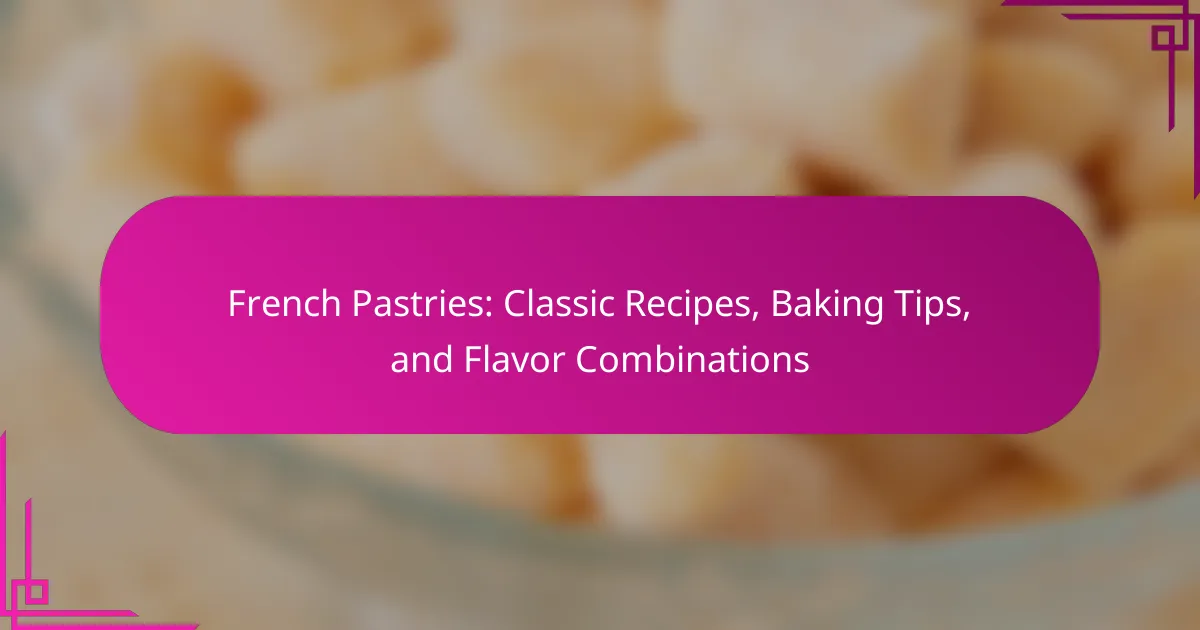French pastries are a renowned category of baked goods characterized by their delicate textures and rich flavors, with popular types including croissants, éclairs, and macarons. This article covers classic French pastry recipes, detailing the essential techniques such as lamination and choux pastry that contribute to their unique qualities. It also emphasizes the importance of precision in baking, including accurate measurements and temperature control, to achieve optimal results. Additionally, the article explores popular flavor combinations that enhance the enjoyment of these pastries, such as chocolate and hazelnut, raspberry and almond, and lemon and meringue. Understanding these elements will help bakers improve their skills and create authentic French pastries.

What are French Pastries?
French pastries are a category of baked goods originating from France. They are known for their delicate textures and rich flavors. Common types include croissants, éclairs, and macarons. French pastries often utilize techniques like lamination and choux pastry. These methods contribute to their lightness and flakiness. The use of high-quality ingredients is essential in their preparation. Many French pastries are enjoyed with coffee or tea. They are a staple in French patisseries and bakeries.
How did French Pastries evolve over time?
French pastries evolved significantly from the Middle Ages to the present day. Initially, pastries were simple and made with coarse flour. The introduction of refined flour in the 17th century improved texture and flavor. The creation of puff pastry in the 18th century marked a turning point, allowing for lighter and flakier pastries. Influences from Italian and Austrian cuisines further enriched French pastry techniques. The establishment of patisseries in the 19th century made pastries more accessible to the public. Innovations in baking technology, such as gas ovens, enhanced consistency and quality. Today, French pastries continue to evolve with modern flavors and techniques while maintaining traditional roots.
What historical influences shaped French Pastries?
French pastries were shaped by various historical influences, including the Renaissance and royal courts. The introduction of sugar and new baking techniques during the Renaissance enhanced pastry-making. French chefs adopted and refined techniques from Italy, leading to the creation of delicate pastries. The influence of the French aristocracy further popularized pastries as symbols of luxury and sophistication. The establishment of pastry shops in the 19th century democratized access to these treats. Additionally, the culinary contributions of notable chefs like Marie-Antoine Carême and Pierre Hermé solidified French pastry’s global reputation. These historical factors collectively contributed to the evolution and mastery of French pastries.
Which regions in France are known for their unique pastries?
The regions in France known for their unique pastries include Brittany, Alsace, and Provence. Brittany is famous for its buttery galettes and kouign-amann. Alsace offers specialties like kugelhopf and bredele, particularly during the holiday season. Provence is renowned for the calisson, a sweet made from almond paste and candied fruit. Each region has distinct ingredients and traditions that influence their pastry creations. These pastries reflect the cultural heritage and local flavors of their respective regions.
What are the key characteristics of French Pastries?
French pastries are known for their delicate textures, rich flavors, and artistic presentation. They often feature layers, such as in puff pastry, which creates a flaky and airy quality. Common ingredients include butter, flour, sugar, and eggs, contributing to their rich taste. French pastries are also characterized by their variety, ranging from croissants to éclairs and tarts. Many pastries are filled or topped with creams, fruits, or chocolate, enhancing their flavor profiles. The preparation techniques, such as folding and rolling, are essential for achieving the desired texture. French pastries are often visually appealing, showcasing intricate designs and finishes. Their historical significance in French cuisine adds to their cultural value.
How does the texture of French Pastries differ from other pastries?
French pastries have a unique texture characterized by their lightness and flakiness. This texture results from the use of techniques such as lamination, where layers of dough and butter are folded and rolled multiple times. This process creates thin layers that puff up during baking, resulting in a delicate, airy structure.
In contrast, many other pastries, such as American-style pastries, tend to be denser and cake-like. French pastries often feature a crisp outer layer with a soft, tender interior. This contrast is particularly evident in items like croissants and éclairs.
The use of high-quality ingredients, such as European butter, also contributes to the superior texture of French pastries. This butter has a higher fat content, which enhances the flakiness and richness. Overall, the meticulous preparation and specific techniques used in French pastry-making create a distinct texture that sets them apart from other pastries.
What flavors are commonly associated with French Pastries?
Common flavors associated with French pastries include vanilla, chocolate, almond, and fruit. Vanilla is a foundational flavor often used in creams and custards. Chocolate is frequently incorporated into ganaches and fillings. Almond flavor is prevalent in pastries like frangipane and macarons. Fruit flavors, such as raspberry, lemon, and pear, are often used in tarts and éclairs. These flavors enhance the sweetness and richness of French pastries. Their use is rooted in traditional recipes and regional variations.

What are some classic French Pastry recipes?
Classic French pastry recipes include croissants, éclairs, and macarons. Croissants are flaky, buttery pastries made from a yeast-leavened dough. They are rolled and folded multiple times to create layers. Éclairs are choux pastry filled with cream and topped with chocolate icing. The dough is piped into long shapes and baked until golden. Macarons are delicate almond meringue cookies filled with ganache or buttercream. These pastries require precision in mixing and baking. Each recipe reflects traditional French techniques and ingredients.
How do you make a traditional Croissant?
To make a traditional croissant, start with a dough made from flour, water, yeast, sugar, and salt. Knead the dough until smooth and let it rise until doubled in size, approximately 1 to 2 hours. Roll the dough into a rectangle and layer cold butter on one half. Fold the dough over the butter and seal the edges. Roll it out again and fold it into thirds. Repeat this process for a total of three folds, chilling the dough between folds. After the final fold, roll the dough into a large rectangle and cut it into triangles. Roll each triangle from the base to the tip to form a crescent shape. Allow the shaped croissants to rise until puffy, about 1 hour. Bake in a preheated oven at 400°F (200°C) for 15-20 minutes until golden brown. The layers create a flaky texture, which is characteristic of traditional croissants.
What ingredients are essential for a perfect Croissant?
The essential ingredients for a perfect croissant are flour, water, yeast, salt, sugar, and butter. High-protein flour provides the necessary gluten structure. Water hydrates the dough and activates the yeast. Yeast is crucial for leavening and creating a light texture. Salt enhances flavor and strengthens gluten. Sugar adds a slight sweetness and aids browning. Finally, butter, preferably unsalted, contributes to the flaky layers and rich taste. Each ingredient plays a vital role in achieving the signature croissant texture and flavor.
What are the steps to achieve the ideal flaky texture?
To achieve the ideal flaky texture in pastries, incorporate cold ingredients and precise techniques. Start with chilled butter, as it creates steam during baking. Cut the butter into flour until pea-sized pieces form, ensuring the fat remains solid. Gradually add cold water to form a dough, mixing minimally to avoid gluten development. Roll the dough into a rectangle, then fold it into thirds to create layers. Repeat this rolling and folding process several times, typically four to six times. Chill the dough between folds to maintain the cold temperature. Finally, bake at a high temperature to ensure the layers puff and create flakiness. This method is supported by culinary techniques used in classic French pastry recipes.
What is the process for creating Éclairs?
The process for creating Éclairs involves several key steps. First, prepare the choux pastry. Combine water, butter, and salt in a saucepan. Bring the mixture to a boil. Remove it from heat and stir in flour until it forms a dough. Next, incorporate eggs one at a time until the mixture is smooth and shiny. Pipe the choux pastry onto a baking sheet in elongated shapes. Bake them in a preheated oven until puffed and golden brown. Once cooled, create a filling using pastry cream. Fill each éclair by injecting the cream into one end. Finally, dip the tops in melted chocolate glaze for the finishing touch. Éclairs are best served fresh to maintain their texture.
What filling options can be used for Éclairs?
Éclairs can be filled with various options. Common fillings include pastry cream, whipped cream, and chocolate ganache. Pastry cream can be flavored with vanilla, coffee, or chocolate. Whipped cream provides a light and airy texture. Chocolate ganache offers a rich, decadent flavor. Other options include fruit curds, custards, and flavored creams. Each filling enhances the éclair’s taste and texture. Éclairs are versatile, allowing for creative combinations of fillings.
How do you create the perfect glaze for Éclairs?
To create the perfect glaze for Éclairs, you need a mixture of icing sugar, water, and flavoring. Start by sifting 200 grams of icing sugar into a bowl. Gradually add 2-3 tablespoons of water until you achieve a smooth consistency. You can incorporate vanilla extract or cocoa powder for added flavor. The glaze should be thick enough to coat the back of a spoon. Dip the top of each Éclair into the glaze to ensure an even coating. Allow the glaze to set before serving. This method ensures a glossy finish that enhances the Éclair’s appearance and flavor.

What baking tips can enhance your French Pastry skills?
To enhance your French pastry skills, focus on precision, temperature control, and technique. Accurate measurements are crucial in pastry baking. Use a digital scale for precise ingredient quantities. Maintain consistent oven temperatures for even baking. Preheat your oven adequately before placing pastries inside. Mastering techniques like folding and lamination improves texture and flakiness. Practice creating a stable meringue for desserts like macarons. Use high-quality ingredients for the best flavor and texture. Understanding the science behind each ingredient can lead to better results.
How can temperature affect the baking of French Pastries?
Temperature significantly affects the baking of French pastries. It influences texture, rise, and browning. For instance, higher temperatures can lead to rapid steam creation. This steam is crucial for achieving flaky layers in pastries like croissants. Conversely, lower temperatures can result in denser textures. Overbaking at high temperatures can cause burnt surfaces and dry interiors. Precision in temperature control is essential for optimal results. Many pastry recipes specify exact temperature ranges for this reason. Consistency in temperature ensures even baking and desired outcomes.
What is the ideal temperature for baking different types of pastries?
The ideal temperature for baking different types of pastries generally ranges from 350°F to 425°F. Puff pastries typically bake best at 400°F to achieve a flaky texture. For tarts and pies, a temperature of 375°F is recommended to ensure even cooking. Cookies and small pastries often require a lower temperature, around 350°F, to prevent burning. Danish pastries benefit from a higher heat of 425°F to create a golden-brown crust. These temperature guidelines are based on standard baking practices and recipes from culinary sources. Proper temperature control is crucial for achieving the desired texture and flavor in pastries.
How does humidity impact pastry dough?
Humidity significantly affects pastry dough by altering its moisture content. High humidity can lead to overly sticky dough, making it difficult to handle. This excess moisture can also prevent the dough from achieving the desired flakiness in baked pastries. Conversely, low humidity can dry out the dough, resulting in a crumbly texture. The ideal humidity level for pastry dough is generally around 60% to 70%. At this level, the dough maintains the right balance of moisture for optimal elasticity and structure. Baking environments with fluctuating humidity can require adjustments in flour or liquid ratios. For example, a humid day may necessitate adding more flour to achieve the correct consistency.
What tools are essential for baking French Pastries?
Essential tools for baking French pastries include a stand mixer, rolling pin, and pastry cutter. A stand mixer is crucial for achieving the right dough consistency. A rolling pin helps in evenly flattening dough for pastries. A pastry cutter is used for cutting butter into flour, which is essential for flaky textures. Additionally, a baking sheet is needed for placing pastries before baking. Parchment paper prevents sticking and ensures even baking. A pastry brush is useful for applying egg wash on pastries for a golden finish. Finally, a thermometer ensures accurate baking temperatures, which is vital for perfect results.
Which kitchen equipment can improve your pastry-making process?
A stand mixer can significantly improve your pastry-making process. It offers consistent mixing speeds and powerful kneading capabilities. This equipment ensures uniform dough consistency, which is crucial for pastries. A food processor can also enhance efficiency by quickly chopping and mixing ingredients. It reduces preparation time, allowing for faster pastry production. A digital kitchen scale is essential for precise measurements of ingredients. Accurate measurements are vital for achieving the right texture and flavor in pastries. A pastry scraper aids in handling dough effectively, minimizing waste. Lastly, a baking stone helps maintain even heat distribution in the oven. This results in perfectly baked pastries with a desirable texture.
How do specific tools contribute to the quality of the final product?
Specific tools enhance the quality of the final product in French pastries by ensuring precision and consistency. For instance, a digital scale allows for accurate measurement of ingredients. This accuracy is crucial for achieving the right texture and flavor. A stand mixer provides thorough mixing, which is essential for proper aeration. Proper aeration leads to lighter and fluffier pastries. Additionally, a pastry cutter enables even distribution of butter in dough. This results in a flaky texture, characteristic of high-quality pastries. Using a thermometer ensures correct baking temperatures, preventing undercooking or overbaking. Each tool serves a specific purpose that directly impacts the final outcome, ensuring the pastry meets professional standards.

What are some popular flavor combinations for French Pastries?
Popular flavor combinations for French pastries include chocolate and hazelnut, raspberry and almond, and lemon and meringue. Chocolate and hazelnut create a rich and nutty experience. Raspberry and almond add a fruity and sweet balance. Lemon and meringue provide a tart and airy contrast. Other combinations are vanilla and coffee, which offer a creamy and robust flavor profile. Pistachio and rose create a unique floral and nutty blend. These combinations are widely used in classic French pastries like éclairs, tarts, and macarons.
How can you pair flavors to enhance French Pastries?
To enhance French pastries, pair complementary flavors that elevate their taste. Classic combinations include chocolate with orange zest, which adds brightness. Almond and raspberry create a rich and fruity profile. Vanilla pairs well with lemon, providing a fresh contrast. Matcha complements sweet red bean for a unique twist. Herbs like basil can enhance fruit fillings, adding depth. Spices such as cinnamon with apple or pear create warmth. Each pairing should balance sweetness and acidity for optimal flavor. These combinations are rooted in traditional French pastry techniques and flavor profiles.
What are classic flavor pairings in French Pastry recipes?
Classic flavor pairings in French pastry recipes include chocolate and hazelnut, vanilla and raspberry, and lemon and almond. Chocolate and hazelnut create a rich, nutty flavor profile often used in tarts and mousses. Vanilla and raspberry provide a sweet and tart contrast, commonly found in éclairs and creams. Lemon and almond offer a refreshing citrus note balanced with nuttiness, frequently used in cakes and pastries. These combinations are rooted in traditional French culinary practices, enhancing the taste and experience of the desserts.
How do seasonal ingredients influence flavor choices?
Seasonal ingredients significantly influence flavor choices in culinary practices. They provide fresh, vibrant tastes that align with specific times of the year. For example, summer fruits like berries offer sweetness and acidity. In contrast, winter root vegetables impart earthiness and warmth. Seasonal ingredients also enhance the overall quality of dishes. They are often more flavorful and nutritious due to optimal growing conditions. Chefs and bakers leverage these ingredients to create dishes that resonate with seasonal themes. Research shows that seasonal eating can enhance the dining experience by connecting flavors to cultural traditions. This practice fosters creativity in flavor combinations, leading to unique pastry offerings.
What are some innovative flavor ideas for modern French Pastries?
Innovative flavor ideas for modern French pastries include matcha green tea, lavender, and salted caramel. Matcha adds a vibrant color and earthy taste, appealing to health-conscious consumers. Lavender provides a floral note, enhancing the sensory experience of pastries. Salted caramel balances sweetness with a savory touch, creating a complex flavor profile. Other unique combinations are pistachio and rose, offering a nutty and aromatic blend. Additionally, yuzu citrus introduces a refreshing tang, perfect for modern interpretations of traditional recipes. These flavors reflect current culinary trends and consumer preferences for diverse and exciting taste experiences.
How can you incorporate unique ingredients into traditional recipes?
Incorporating unique ingredients into traditional recipes can enhance flavor and creativity. Start by identifying a traditional recipe, such as a classic French pastry. Then, select a unique ingredient that complements the original flavors. For example, consider adding lavender to a lemon tart for a floral note. Alternatively, use matcha in a pâte à choux for a vibrant color and taste. Adjust the quantities of sugar and other seasonings to balance the new ingredient’s profile. Experiment with textures by incorporating nuts or seeds into fillings. Research shows that innovative combinations can elevate culinary experiences, as seen in a study by the Culinary Institute of America. This approach maintains the essence of the original dish while introducing exciting new elements.
What trends are emerging in the world of French Pastry flavors?
Emerging trends in French pastry flavors include the use of global ingredients and innovative techniques. Chefs are incorporating flavors like matcha, yuzu, and tahini into traditional pastries. There is a growing focus on plant-based and gluten-free options. Pastries are increasingly featuring savory elements, such as herbs and spices. Seasonal and locally sourced ingredients are becoming more prominent in flavor profiles. Additionally, fusion desserts that blend French techniques with other culinary traditions are gaining popularity. These trends reflect a shift towards creativity and inclusivity in the pastry world.
What are some common troubleshooting tips for French Pastry baking?
Ensure proper ingredient measurements to avoid inconsistencies. Use a kitchen scale for accuracy. Preheat the oven thoroughly to maintain even baking temperatures. Check oven calibration if pastries are unevenly baked. Allow dough to rest adequately to prevent shrinkage. Use cold ingredients, especially butter, for flaky textures. Monitor baking times closely; overbaking can lead to dryness. Humidity affects pastry outcome; adjust baking conditions accordingly.
French pastries are a renowned category of baked goods from France, characterized by their delicate textures and rich flavors, with popular varieties including croissants, éclairs, and macarons. The article explores the evolution of French pastries from simple medieval origins to sophisticated creations influenced by various culinary traditions, highlighting key characteristics, regional specialties, and classic recipes. Additionally, it provides essential baking tips, troubleshooting advice, and innovative flavor combinations to enhance the pastry-making experience, emphasizing the importance of technique and quality ingredients.
